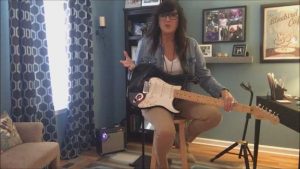Help, I’m Strapped! [Setting Guitar Players Free]
I want to talk to you guitar players out there who are in a band, but not singing lead. You might be wondering what YOU’RE supposed to do to be interesting onstage. [Part 2 will focus on some additional things more applicable to lead players.]
We’ve found that a typical rehearsal involving guitar players usually comes with some excuses when it comes to movement; ‘I can’t move because I have to focus on what I’m playing’…’I can’t go far because of my cord’…’I have to switch on my pedal here’…’I can’t hear my amp if I move’…and many more. I’m sure you have your own to add.
But Tom and I have found there are remedies for almost every excuse not to move away from your cozy little ‘home base’ behind your guitar, mic stand, pedal board, and amp. Let me show you how you can free yourself so you can connect with the audience and be more interesting to watch.

First of all, get yourself wireless. There are good units that won’t compromise your sound, and even if there IS a slight difference, the audience won’t be able to tell. This gives you one less thing to think about onstage…the last thing you need is to be worried about tripping on cables.
Next, try to lighten up your pedal board to what you really need and use, or at the very least position it to the side or at an angle so it’s not directly in front of you. I realize in some cases this might not be possible if you have a lot of songs where you have to ride a ‘wah’ or volume pedal, but in most cases I’ve found where it’s an occasional on/off switch, moving your board is possible.
What we’re trying to do here is eliminate barriers between you and the audience whenever possible. Keep in mind that some pedals YOU think make a big difference sound-wise, don’t even register with the audience. Unless it’s something very distinctive, we’re not going to hear a subtle nuance in a live setting.
Some of you are relying too much on your amps to hear yourself. Mic-ing your amp and running it through your in-ears will enable you to get the mix you want and allow you to move away from it.
If you sing background vocals from time to time, position your mic so you can easily get to it for the vocals, but aren’t blocked behind it when you’re not singing. Stepping up to the mic right before your part comes in, shows the audience you’re getting ready to sing and their ears will tune in to you. If you’re always behind the stand, we don’t know when to pay attention to your part.
SO, now that you’re out of excuses to move, let’s be interesting to watch, ok?? We want to see you interacting with the rest of the band, so go someplace else onstage! This is important for several reasons;
First of all, people in the audience that are not close to your ‘home base’ spot, want to see you and be the subject of your attention, so venturing to other parts of the stage and making eye contact with the audience there, accomplishes that.
Secondly, you need to be able to balance the stage. For example, when the lead singer moves in front of you, you should move either right or left to ‘right the ship’ and balance the visual feel of what the audience sees. It’s subtle, but noticeable, and just FEELS right to those watching you.
Lastly, we want to see you interact with the other players onstage. Walk or run over to them to jam together, especially if you’re playing the same groove, lick or rhythmic thing. This will help us ‘see’ the riff, and as a result, really HEAR it… plus it lets us see that you actually like playing with these people!
Stay tuned for part II…. In the meantime though, post your questions or comments and let us know what YOU’RE doing to get freed up!

